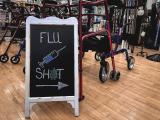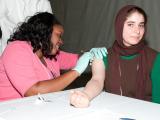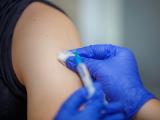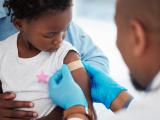Dec 16, 2004 (CIDRAP News) – Federal health officials painted a rosy picture of the influenza vaccine supply today, saying most states have enough vaccine and the nation as a whole seems to have enough to meet the demand from groups who need the shots the most.
Julie Gerberding, MD, MPH, director of the Centers for Disease Control and Prevention (CDC), said a recent survey showed that 82% of the 49 responding states had enough flu vaccine to meet their demand this year. The survey was conducted by the Association of State and Territorial Health Officials, she said.
In addition, a CDC report published today says, "Adequate doses of vaccine appear to remain to meet the anticipated demand among priority groups for influenza vaccination, based on 2003-04 coverage estimates" from a CDC survey.
Speaking at a teleconference, Gerberding said 21 million doses of flu vaccine have been distributed since the current shortage began in early October, and about 3.5 million doses of licensed vaccine are still to come. Another 1.2 million doses of non-US-licensed vaccine made in Germany by GlaxoSmithKline are not yet being used, she said.
The loss of an expected 48 million doses of vaccine because of contamination at a Chiron Corp. plant in England prompted the CDC to recommend in early October that the available doses be reserved for people at risk for serious flu complications. Those groups include the elderly, the chronically ill, pregnant women, children 6 to 23 months old, older children who take daily aspirin, and healthcare workers who care for patients.
The CDC's Advisory Committee on Immunization Practices will meet tomorrow to discuss whether to broaden the guidelines, Gerberding said. "I'm not going to second-guess them," she said. But last week the CDC suggested that state health departments could expand eligibility for the shots if they had already met the demand from high-risk groups.
"We know that some states have a surplus of vaccine in the hands of private providers," Gerberding said today. "We're asking providers who have large numbers of doses to make it available to state health officials so they can redistribute it."
This year's flu season continues to be relatively quiet, Gerberding said. New York is the only state reporting widespread flu activity; most states have only sporadic cases. "But the peak time is February, so we're not assuming that we're out of the woods yet," she said.
The CDC published a flurry of survey results on flu vaccination and related topics in today's issue of Morbidity and Mortality Weekly Report. Overall, the reports suggest that most of the doses this season have gone to people in high-priority groups, but many in those groups have not yet been vaccinated.
In one survey, part of the monthly Behavioral Risk Factor Surveillance System series, the CDC interviewed more than 16,700 people this month. The survey showed that 34.8% of adults in high-risk groups had received a shot between September and November of this year, compared with 4.4% of other adults. Coverage was about 51% for people age 65 and older and about 34% for healthcare workers with patient contact. For children aged 6 to 23 months, the vaccination rate was 36.6%.
Among high-risk adults who had not been vaccinated, about 23% said they had tried unsuccessfully to get a shot. About 32% of unvaccinated elderly people had tried and failed to get a shot.
On the basis of the survey, the CDC estimates that about 45 million noninstitutionalized people had received flu shots as of Nov 30 and that about 73% of them were in the high-risk groups.
Because an estimated 58 million doses of licensed injectable flu vaccine and 3 million doses of intranasal vaccine are expected to be available in the nation this season, the CDC expects that enough doses will be available to meet the remaining demand from high-priority groups, the report says.
The survey did not cover nursing home residents, but the findings suggest that enough vaccine will be available to meet the needs of the 1.5 million people in nursing homes, the CDC says.
Gerberding said that many people eligible for a shot believe vaccine is not available or think they are not eligible. To those in the high-risk groups, she said, "Keep trying, be persistent, and we'll do everything we can to get vaccine to you."
See also:
CDC. Estimated influenza vaccination coverage among adults and children—United States, September 1–November 30, 2004. MMWR 2004 Dec 17;53(49):1147-53 [Full text]


















